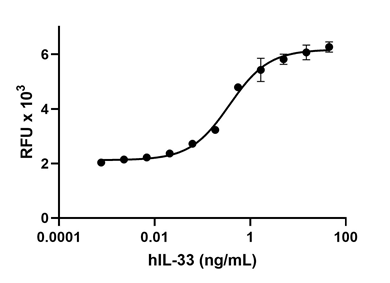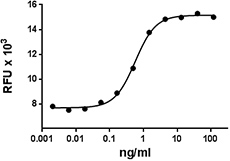- Regulatory Status
- RUO
- Other Names
- IL-25
- Ave. Rating
- Submit a Review
| Cat # | Size | Price | Quantity Check Availability | Save | ||
|---|---|---|---|---|---|---|
| 598902 | 5 µg | $94 | ||||
| 598904 | 25 µg | $218 | ||||
This product is not available for shipping outside of the United States.
IL-17E, also known as IL-25, promotes Th2 biased immune responses. This is in contrast to other IL-17 family members which promote Th1 and Th17 biased inflammation. IL-17E is an important mediator of allergic reactions and protection against intestinal parasites. During helminth infections and allergic reactions, IL-17E production is locally upregulated in intestinal cells, airway epithelial cells, atopic dermatitis skin lesions, local Th2 cells, eosinophils, and basophils. It binds to IL-17RB but also requires IL-17RA to exert its activity. IL-17E acts on a variety of cell types which respond with increased production of Th2 cytokines and reduced production of Th1 and Th17 cytokines. Airway IL-17E can be activated by MMP7, a protease that is upregulated in airway epithelium in response to allergen exposure. Cleaved IL-17E shows enhanced binding to IL-17RB and stronger induction of Th2 cytokines. The Th2 cytokines, in turn, trigger the expansion of Th2 memory cells and anti-inflammatory M2 macrophages, increased eosinophil mobilization and activation, and dendritic cell migration. These actions promote protective anti-helminth immune responses as well as allergic inflammation and airway hyperreactivity. IL-17E also promotes vascular endothelial cell proliferation and assembly into tubular structures. It also supports the integrity of the blood brain barrier and limits CD4+ T cell infiltration into the brain.
Product DetailsProduct Details
- Source
- Human IL-17E, amino acids (Tyr33-Gly177) with an additional Met at the N-terminus (Accession# NP_073626.1), was expressed in E. coli.
- Molecular Mass
- The 146 amino acid recombinant protein has a predicted molecular mass of approximately 17 kD. Recombinant human IL-17E forms a non-disulfide-linked homodimer (34 kD). The predicted N-terminal amino acid is Met.
- Purity
- >98%, as determined by Coomassie stained SDS-PAGE.
- Formulation
- Lyophilized
- Endotoxin Level
- Less than 0.1 ng per µg of protein.
- Storage & Handling
- Unopened vial can be stored at -20°C or -70°C. For maximum results, quick spin vial prior to opening. Reconstitute in water to a concentration of 0.1-1.0 mg/ml. Do not vortex. It is recommended to further dilute in a buffer containing a carrier protein such as 0.1% BSA and store working aliquots at -20°C to -80°C. Avoid repeated freeze/thaw cycles.
- Activity
- Human IL-17E is able to induce IL-8 secretion in human PBMCs using a concentration range of 10 - 100 ng/ml. Note: Results will vary with PBMC donors.
- Application
-
Bioassay
Antigen Details
- Structure
- Cytokine
- Distribution
- T cells, neurons
- Function
- Human IL-17E plays an important role in inflammatory responses, anti-tumor immunity, airway remodeling, and autoimmune diseases.
- Interaction
- Fibroblasts, endothelial cells, epithelial cells, keratinocytes, macrophages.
- Ligand/Receptor
- IL-17RB
- Bioactivity
- Human IL-17E induces IL-8 secretion in PBMCs.
- Biology Area
- Apoptosis/Tumor Suppressors/Cell Death, Cell Biology, Immunology, Signal Transduction
- Molecular Family
- Cytokines/Chemokines
- Antigen References
-
1. Gaffen SL. 2009. Nat. Rev. Immunol. 9:556.
2. Cua DJ, and Tato CM. 2010. Nat. Rev. Immunol. 10:479.
3. Shi Y, et al. 2000. J. Biol. Chem. 275:19167.
4. Li H, et al. 2000. Proc. Natl. Acad. Sci. USA 97:773.
5. Moore EE, et al. 2002. Neuromuscul. Disord. 12:141.
6. Kokubu T, et al. 2008. J. Histochem. Cytochem. 56:89.
7. You Z, et al. 2005. Biochem. Biophys. Res. Commun. 326:624.
8. Yamaguchi Y, et al. 2007. J. Immunol. 179:7128. - Gene ID
- 64806 View all products for this Gene ID
- UniProt
- View information about IL-17E on UniProt.org
Related FAQs
- Why choose BioLegend recombinant proteins?
-
• Each lot of product is quality-tested for bioactivity as indicated on the data sheet.
• Greater than 95% Purity or higher, tested on every lot of product.
• 100% Satisfaction Guarantee for quality performance, stability, and consistency.
• Ready-to-use liquid format saves time and reduces challenges associated with reconstitution.
• Bulk and customization available. Contact us.
• Learn more about our Recombinant Proteins. - How does the activity of your recombinant proteins compare to competitors?
-
We quality control each and every lot of recombinant protein. Not only do we check its bioactivity, but we also compare it against other commercially available recombinant proteins. We make sure each recombinant protein’s activity is at least as good as or better than the competition’s. In order to provide you with the best possible product, we ensure that our testing process is rigorous and thorough. If you’re curious and eager to make the switch to BioLegend recombinants, contact your sales representative today!
- What is the specific activity or ED50 of my recombinant protein?
-
The specific activity range of the protein is indicated on the product datasheets. Because the exact activity values on a per unit basis can largely fluctuate depending on a number of factors, including the nature of the assay, cell density, age of cells/passage number, culture media used, and end user technique, the specific activity is best defined as a range and we guarantee the specific activity of all our lots will be within the range indicated on the datasheet. Please note this only applies to recombinants labeled for use in bioassays. ELISA standard recombinant proteins are not recommended for bioassay usage as they are not tested for these applications.
- Have your recombinants been tested for stability?
-
Our testing shows that the recombinant proteins are able to withstand room temperature for a week without losing activity. In addition the recombinant proteins were also found to withstand four cycles of freeze and thaw without losing activity.
- Does specific activity of a recombinant protein vary between lots?
-
Specific activity will vary for each lot and for the type of experiment that is done to validate it, but all passed lots will have activity within the established ED50 range for the product and we guarantee that our products will have lot-to-lot consistency. Please conduct an experiment-specific validation to find the optimal ED50 for your system.
- How do you convert activity as an ED50 in ng/ml to a specific activity in Units/mg?
-
Use formula Specific activity (Units/mg) = 10^6/ ED50 (ng/mL)

 Login/Register
Login/Register 

















Follow Us